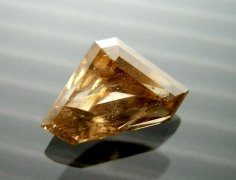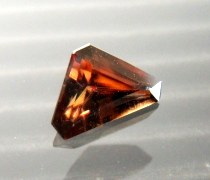 |
| ファセット・カットされた錫石(faceted cassiterites) 3.80ct(Bolivia) and 1.11ct( Brazil) |
錫石(Cassiterite)
 |
| ファセット・カットされた錫石(faceted cassiterites) 3.80ct(Bolivia) and 1.11ct( Brazil) |
| 化学組成 (Composition) |
結晶形 (Crystal Forms) |
結晶系 (Crystal System) |
モース硬度 (Hardness) |
比重 (Density) |
屈折率 (Refractive Index) | ||||
| SnO2 |  |
 |
 |
 |
 |
正方晶系 (Tetragonal) |
6−7 | 6.95±0.08 | 1.997 - 2.093 |
| 正方輪座 3連晶 |
正方9連晶 | ||||||||
| multiple twins | |||||||||
錫石の名前と産状 (Name, Origin and Occurence)
年間15万トン余り生産される錫ですが、錫を含む鉱物は僅か4種類しかありません。
数少ない錫鉱石の中で、単純な組成の錫の酸化物である錫石が主要な鉱石です。
英語の俗称 ”tin stone : 錫石” と呼ばれる所以です。
”Cassiterite” はギリシア語で錫を意味する ”kassiteros” に因み命名されました。
一方で錫の元素記号 Sn はラテン語で錫を意味する Stannum に由来しイタリア語の ”stagno(スタンニョ)”, フランス語の ”etain (エタン)” , スペイン語の ”estaño (エスターニョ)” ,英語の tin, stannary (錫鉱区)、ドイツ語の ”Zinn (ツィン)、錫器 : Stanniol " 等のヨーロッパ語に残っています。
錫石に次ぐ錫鉱石である黄錫鉱 (stannite : Cu2FeSnS4 ) は直訳するとこちらの方も錫石となります。
錫石は主に花崗岩を伴う高温の熱水起源の鉱物ですが、スカルンやグライゼン等、変成作用による鉱床にも発見されます。また風化作用による大規模な漂砂鉱床も主要な鉱床となります。
結晶は不純物の鉄による濃褐色や黒の不透明な短柱状や両錐形に加えて、複雑な反復双晶が見られます。
There are only 4 tin containing minerals. Most of 150,000 tons of annual tin production is obtained practically from single oxide tin mineral, cassiterite, which name derives from Greek "kassiteros " meaning tin. Element symbol of tin Sn derives from Latin "stannum : tin", which is succeeded to major European languages ; stagno : Italian, estaño : Spanish, étain : French, tin, stannary : English, Zinn, Stanniol : German, and in the name of minor tin ore, stannite(Cu2FeSnS4).
The origin of cassiterite is magmatic in pegmatite, hydrothermal in high-temperature deposits associated with granites and altered rocks ; also very abundant in some alluvial deposits.
Crystals are usually short prismatic, sometimes slender prismatic or bipyramidal and multiple twins are common. The color is generally brown to black due to iron impurity and rarely colorless.
Cassiterite 110mm
Yunnan, ChinaCassiterite 25mm with scheelite and zinnwaldite
Cínovec, Czech Republic
 |
 |
| 3.80ct 10.5x6.3mm Bolivia |
1.11ct
7.2x4.6mm Bahia, Brazil |
宝石質の錫石 (Rare gemmy cassiterite)
宝石鉱物は普通はアルミニウム、リチウム,ベリリウム、マグネシウム、硼素等の軽金属の酸化物や珪酸塩が大半です。
したがって錫のような重金属を主成分とする鉱物が宝石にもなるというのはいささか驚きです。
もっともジルコニウムや更に重いタングステンを主成分とする鉱物も宝石としてカットされます。
要するにどんな鉱物であれ、宝石としてカットされるほどの美しい結晶がありうるという良い例でしょう。
とは言え、錫石には常に鉄分が入り込むので濃褐色や黒の不透明な結晶が殆どです。
稀にカットされる石もボリビア産の石のように全く見映えがしません。
そのため20年も昔に入手したまま放置されていました。最近入手したブラジルのバイア産の石がなかなかの美しさで、ようやくお供として晴れの舞台に登場したような次第です。
Gems are in general, oxide or silicate of light minerals such aluminum, lithium, berylium, magnesium and boron, etc. Therefore, it is rather surprising that a mineral, containing heavy metal such as tin could be faceted as gemstone. There are some gemstones with zirconium and much heavier tungsten as major element.
These are good examples that any crystals can be faceted for gemstones. However, faceted cassiterite is extremely rare due to common iron impurity. A dull colored 3.80 carat Bolivian stone has been neglected for over 20 years in my collection box. Thanks to the newly arrival of relatively pretty Brazilian stone, they are now on display, finally.
Top Gemhall